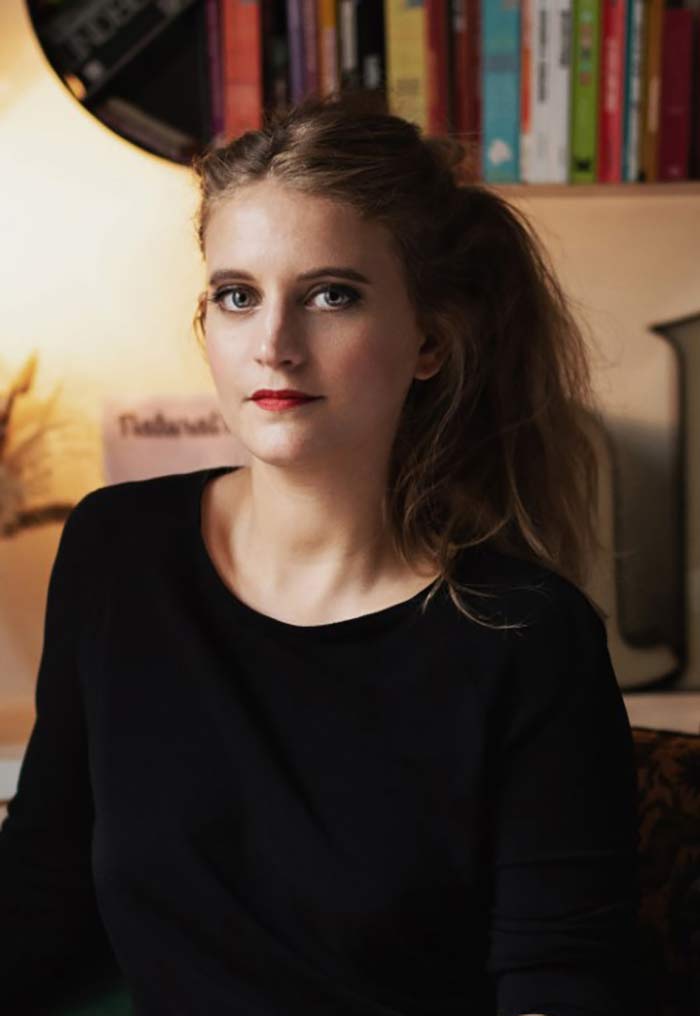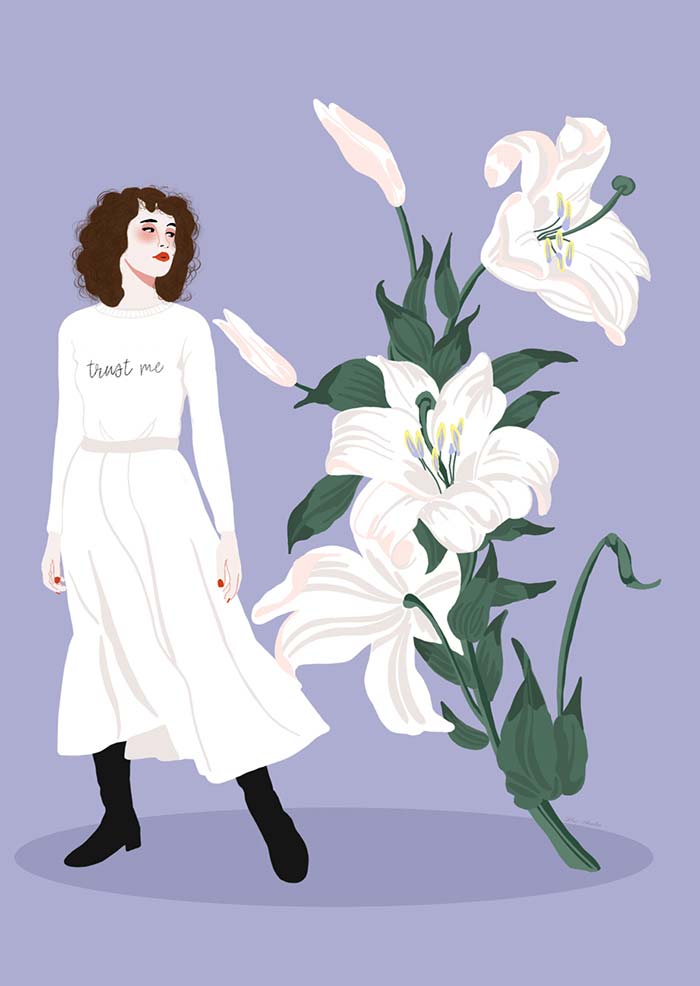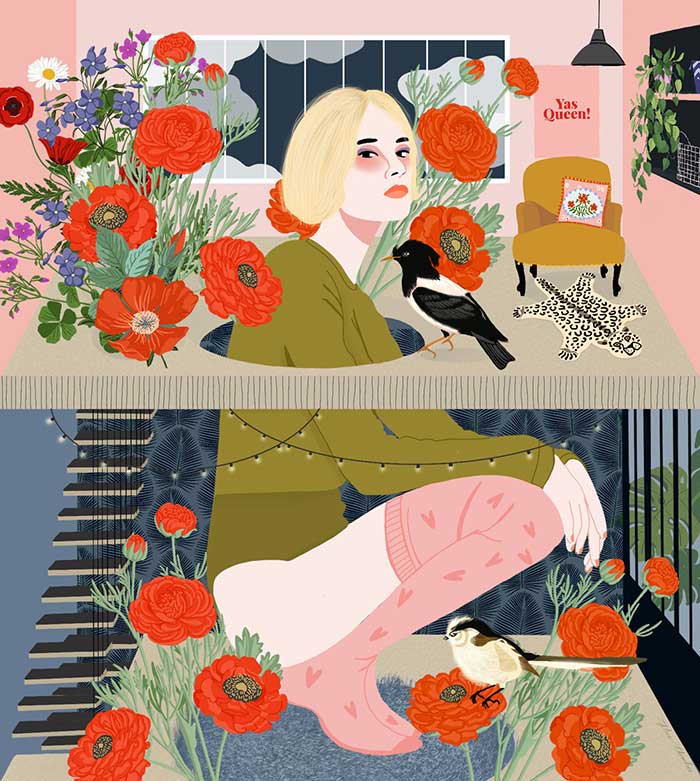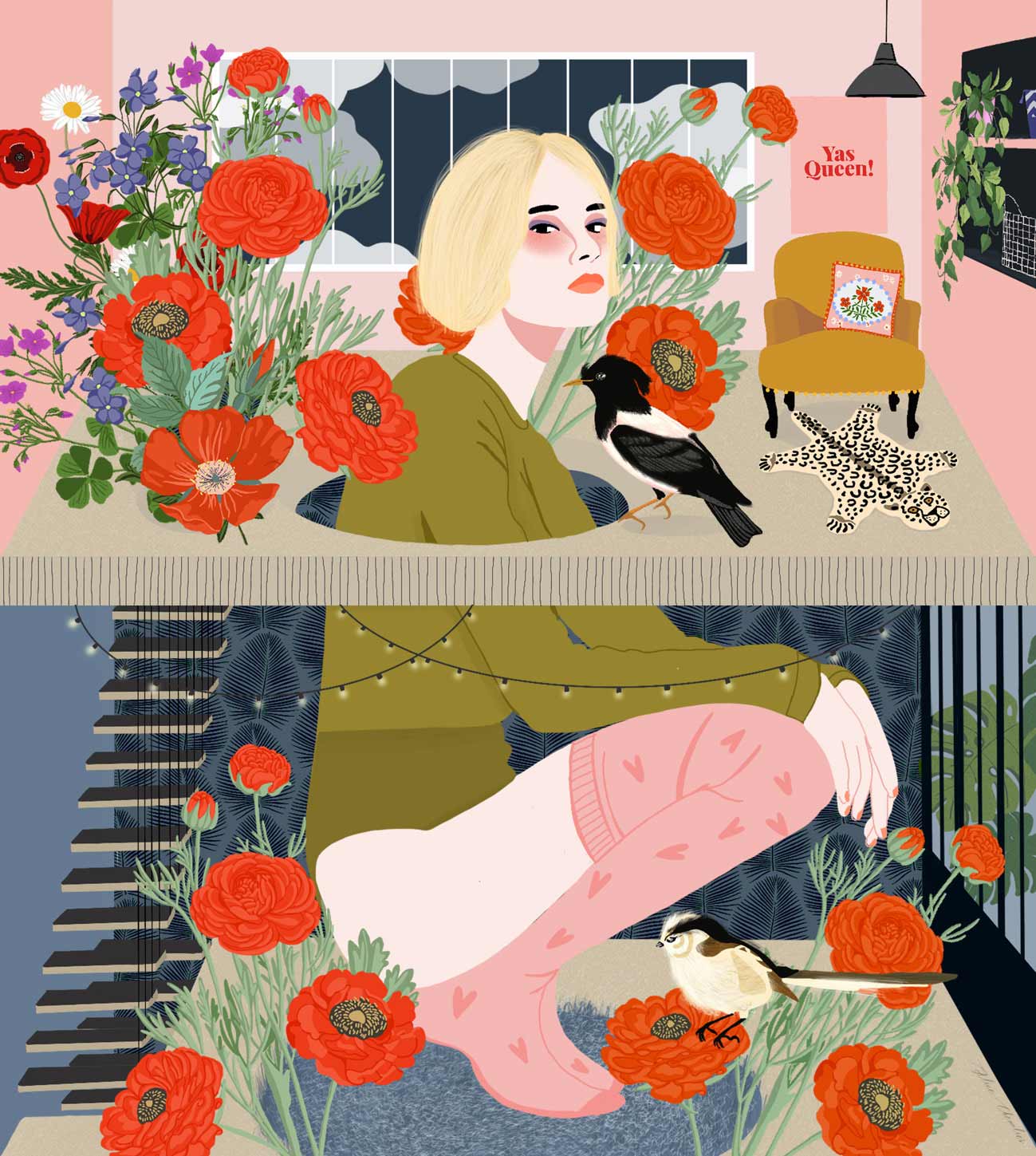Alice Chevalier asks a critical question about how we accept the unacceptable norms of beauty in todays society, via her digital illustrations.
I often wonder how we came to terms with the fact that excessively retouched women have become the norm. It may be our role today – to bring the normal (our differences) up to date with the spiritual.
Alice Chevalier
Featured image: Corona mansion.

Artist portrait: Alice Chevalier. Image credit: Alice Boursini
Please tell us a little about yourself, what brought you to the world of art and how did you start?
I was born in 1984 and live in Paris. My journey is rather simple, like many artists I imagine, I have never stopped creating and drawing since I was a child. My parents love Art, Architecture and Design, and naturally I followed this path. I passed a literary BAC with an applied arts option and then joined a private Parisian school called the “higher institute of applied arts”. After a year of prep, I studied interior architecture and environmental design. I secretly had, within me, a dream of becoming an artist, but my need for security pushed me to exercise this profession for several years.
Then, in 2016 I lived what is spiritually called “the dark night of the soul” a disturbing moment in my life because I was no longer happy and satisfied, everything was dark, I had the choice to persist on a path that I had traced or to take the one of my dreams, which I did as you will have understood by becoming an illustrator at 34 years old – my most beautiful reconversion!
The codes have changed, the superficial and aesthetic have taken over. Just look at who the society admires and erects as gods and goddesses today.
What is the primary role of an artist? How do you describe yourself in the context of challenging people’s perspectives via your work and art?
I feel it would be pretentious to assume that we have a big role in this modern society. Personally, my favourite subject is the embodiment of women today. The codes have changed, the superficial and aesthetic have taken over. Just look at who the society admires and erects as gods and goddesses today. I often wonder how we came to terms with the fact that excessively retouched women have become the norm. It may be our role today – to bring the normal (our differences) up to date with the spiritual. Putting our individuality back in the spotlight, our differences is a wealth, so why do we persist entering predefined boxes?
Our goal is to elevate ourselves in this world, so we must collectively bring it to reflect or to wonder about what is wrong. This is the role of an artist and ultimately of all human beings – this is exactly the definition of creation. Being a creator is within the reach of anyone as long as he can master a little bit of imagination. But it seems to me that we all have it? The rest is just training and practice.

Coquelicots.
How do you deal with the conceptual difficulty and uncertainty of creating work?
Are we talking about the famous “blank page”? It is always frustrating to confront it because it is as if ALL of our creative mechanism was blocked suddenly and it is impossible for us to produce anything. This phenomenon often happens to me when I am tired or when I cannot exactly reproduce or express what I have in my mind. In these moments, either I take a break, or I will look for an outside source of inspiration or I will move on to another drawing and come back to it a few hours / days later.
What would you call your style? Let’s talk about the evolution of your practice over the years. Tell us about your commitment to your current medium.
I left the material behind for digital. Today I draw on an iPad, I like the idea of ‘the right to make mistakes’ with this medium. Sometimes I spend an hour modifying a colour to find a harmony that suits me. I like the perfect flat applications and the unity, it is therefore the ideal tool for me. That said, my desire to come back to painting often tickles me. As for my style, good question, I admit that I don’t know where to put myself.
Generally the women I draw are my alter egos so I take advantage of them to divulge my intimacy in my story while blurring the trail.
What inspires you? Let’s talk about your frameworks, references and process.
Everything inspires me in itself. It can be a gesture or a posture on a photo that gives me a whole story. If I am nostalgic for my childhood, I would integrate an element of it in my composition. If I miss a person, I will draw them as an animal so that I can interact with them again. Generally the women I draw are my alter egos so I take advantage of them to divulge my intimacy in my story while blurring the trail. The subject of death is very present in my work but as I describe it with beautiful artifices and joyful colours no one suspects its presence.

Le lys.
Let’s talk about your career, or if you prefer artistic journey. What were your biggest learning and hiccups along the way?
My career in the illustration world is rather short so I learn and observe this environment with new eyes. The only negative side that I will see in the artistic world are these numerous requests to provide free work or to undervalue our work on the pretext that we are not as well known. It happens very often that a person asks me to exploit a work that he spotted on my site or my Instagram account, for free. The concern when one does not yet have “legitimacy” is to fall into the pitfall of “I need to be visible and therefore to accept everything that falls into our hands”.
What are you looking for when you look at other artists’ work? Which shows, performances and experiences have shaped your own creative process? Who are your maestros?
I am a great admirer and very much inspired by the work of Frida Kahlo. This woman has exposed her guts – it takes courage to reveal her fears, her traumas, her accidents, her “faults” or even to display her opinions. It has become a recurrent theme for me over time and I imagine it is the thing that I look at in the work of other artists.
Think of the biggest professional risk you’ve taken. What helped you take that risk?
The only risk I took was to start my life all over again without knowing where it was going to lead me … and it worked for me! As the saying goes “who risks nothing has nothing”!
What is the best piece of advice you’ve received?
‘Free yourself from the eyes of the other’, this is the best advice I have ever received in my life and it is a complex exercise but when you apply it, opens the door to confidence in oneself and in one’s work .

La etre.
Tell us about your studio, what kind of place is it? Could you describe your usual work-day in the studio?
I’m going to disappoint you on this point because I simply work at home, on my sofa. My days are organised in roughly the following way: I answer my emails in the morning and then continue between 8 to 12 hours of drawing a day. But I reassure you, I take a break of 20/30 minutes for lunch! I usually start my days with orders from my customers and if I have the time I make an illustration to feed my Instagram.
What was your first sale? Do you handle the commercials yourself or is it outsourced to a gallery/agent?
To be able to obtain a wider range of clients and projects, I want to join an artistic agency. I have an Etsy shop for now and I organise an exhibition every year in Paris. I understood that it was necessary to adapt to this modern world, believe it or not, but my biggest business contributor remains Instagram where I am spotted by magazines and brands.
How does your audience interact and react to the work you put out into the world?
So far very positively. It’s always very moving to post a drawing on Instagram, because sometimes you can receive an unexpected shower of compliments. It can go from a simple ‘heart’ to a long discussion on a personal experience. A woman who had lost her brother and had written me a private message thanking me for expressing so freely the stages of mourning she had gone through. I recently enlarged my community thanks to a drawing which represented a woman, seated on her house, receiving a letter from a bird. I drew it during the confinement and the reactions were pretty crazy.
This communication breakdown has destabilised many of us. I had a special relationship with my mailbox, when I went out (once a week) I opened it with the secret hope of finding a letter. I will not lie to you, the only ones that I received were just bills, pretty disappointing.

Corona mansion.
What are you working on now? What’s coming next season?
I am very passionate about cartomancy (my grandmother consulted the cards). I have just completed an oracle inspired by Miss Lenormand’s card . Still have to tweak it and eventually find a publishing house for it. Am happy to see that the practice of tarot is becoming more democratic because it is a very good tool for personal development.
The tarot speaks about the cycle of the life of a human on this earth, it approaches several fields (the spiritual, the mental, the concrete life, the desires) and allows us to better understand the stages of life through which we pass. Fascinating!
What were you working on when the lockdown was announced? How has this affected your practice and plans? How are you balancing life and work at home during this period?
I was drawing the tarot deck. When the confinement started it cut me off from that desire. It was as if no longer seeing the world and suffering the passage of time had slowed me down. Impossible to imagine the world and to influence it with poetry. My apartment had become a prison where I had lost all my bearings. I regretted not to go and take refuge in a house close to nature, so I took an artistic break to re-appropriate it. I spent two weeks sorting and tidying up – it did me a lot of good. The paradox in this story is that I work at home, so I usually stay locked up during the week.
I lived the confinement, alone, at home so when the inspiration came back, I went back to work as if nothing had happened. I used to work 2-3 weeks in a row without taking a break, all I had to do was find a project. It was at this time that I had my Eureka moment and that the idea of reinterpreting Miss Lenormand’s card game came to my mind.
Before you go – you might like to browse our Artist Interviews. Interviews of artists and outliers on how to be an artist. Contemporary artists on the source of their creative inspiration.












Add Comment